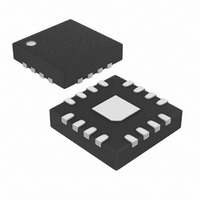MAX4206ETE+T Maxim Integrated Products, MAX4206ETE+T Datasheet - Page 14

MAX4206ETE+T
Manufacturer Part Number
MAX4206ETE+T
Description
IC AMP TRANS LOG 16-TQFN
Manufacturer
Maxim Integrated Products
Datasheet
1.MAX4206ETET.pdf
(17 pages)
Specifications of MAX4206ETE+T
Amplifier Type
Logarithmic
Number Of Circuits
1
Slew Rate
12 V/µs
Gain Bandwidth Product
5MHz
Voltage - Input Offset
1000µV
Current - Supply
5mA
Current - Output / Channel
58mA
Voltage - Supply, Single/dual (±)
2.7 V ~ 11 V, ±2.7 V ~ 5.5 V
Operating Temperature
-40°C ~ 85°C
Mounting Type
Surface Mount
Package / Case
16-TQFN Exposed Pad
Number Of Channels
1
Input Offset Voltage
5 mV
Operating Supply Voltage
3 V, 5 V, 9 V
Supply Current
5 mA
Operating Temperature Range
+ 85 C
Mounting Style
SMD/SMT
Power Dissipation
1349 mW
Lead Free Status / RoHS Status
Lead free / RoHS Compliant
Output Type
-
-3db Bandwidth
-
Current - Input Bias
-
Lead Free Status / Rohs Status
Details
Precision Transimpedance Logarithmic
Amplifier with Over 5 Decades of Dynamic Range
Figure 5. Single-Supply Typical Operating Circuit
The scale factor, K, is the slope of the logarithmic output.
For the LOGV1 amplifier, K = 0.25V/decade. When oper-
ating from dual supplies, adjust the overall scale factor
for the MAX4206 using the uncommitted LOGV2 amplifi-
er and the following equation, which refers to Figure 6:
Select R
Desired:
Dual-Supply Operation
Logarithmic intercept: 1µA
Overall scale factor = 1V/decade
Select R
14
I
IN
______________________________________________________________________________________
R
100Ω
C
100pF
COMP
COMP
2
1
0.1µF
between 1kΩ and 100kΩ.
= 10kΩ:
R
C
100pF
500kΩ
R
2 10
COMP
0.1µF
100Ω
COMP
R
=
SET
R
k
SET
Ω
R
×
LOGIIN
REFIOUT
REFIIN
REFVOUT
REFISET
2
=
=
1
10 1
V decade
R
0 5
1
/
GND
×
.
0 25
MAX4206
.
0 25
V
µ
V
V
.
K
CC
CC
A
V
EE
=
CMVOUT
50
=
LOGV2
CMVIN
LOGV1
OSADJ
SCALE
k
Ω
Design Example
40
k
Ω
V
Scale Factor
OUT
R
0Ω
R1
10kΩ
R2
30kΩ
OS
0.1µF
A photodiode provides a convenient means of measur-
ing optical power, as diode current is proportional to
the incident optical power. Measure absolute optical
power using a single photodiode connected at LOGIIN,
with the MAX4206’s internal current reference driving
REFIIN. Alternatively, connect a photodiode to each of
the MAX4206’s logging inputs, LOGIIN and REFIIN, to
measure relative optical power (Figure 7).
In absorbance measurement instrumentation, a refer-
ence light source is split into two paths. The unfiltered
path is incident upon the photodiode of the reference
channel, REFIIN. The other path passes through a sam-
ple of interest, with the resulting filtered light incident on
the photodiode of the second channel, LOGIIN. The
MAX4206 outputs provide voltages proportional to the
log ratio of the two optical powers—an indicator of the
optical absorbance of the sample.
In wavelength-locking applications, often found in
fiberoptic communication modules, two photodiode cur-
rents provide a means of determining whether a given
optical channel is tuned to the desired optical frequency.
In this application, two bandpass optical filters with over-
lapping “skirts” precede each photodiode. With proper fil-
ter selection, the MAX4206 output can vary monotonically
(ideally linearly) with optical frequency.
Figure 6. Dual-Supply Typical Operating Circuit
I
IN
R
100Ω
C
100pF
COMP
COMP
0.1µF
C
100pF
R
0.1µF
COMP
50kΩ
100Ω
COMP
R
SET
Measuring Optical Absorbance
LOGIIN
REFIOUT
REFIIN
CMVIN
CMVOUT
REFISET
MAX4206
GND
V
V
CC
CC
REFVOUT
V
V
EE
EE
LOGV2
SCALE
LOGV1
OSADJ
0.1µF
V
OUT
R1
10kΩ
R4
R2
40kΩ
R3








